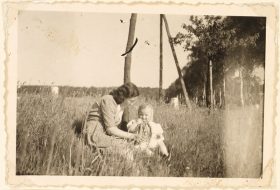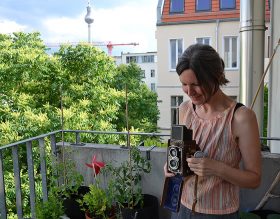The third episode in our blog series “Memories from the Life of Walter Frankenstein”
“Her and no one else,” said Walter Frankenstein the first time he saw his future wife Leonie Rosner in the courtyard of the Auerbach Jewish Orphanage. Leonie was from Leipzig and in Berlin she had begun training at the Jewish Seminar for Nursery School Teachers.

Leonie Frankenstein with her son Peter-Uri sitting in a meadow, Brzeźno in Gorzów County (German: Briesenhorst), May 1944; Jewish Museum Berlin, gift of Leonie and Walter Frankenstein
After it was closed, she came to the Auerbach Jewish Orphanage as an apprentice. Soon after her arrival, Leonie’s room quickly became the place where apprentices living in the orphanage met. Seventeen-year-old Walter grew closer to Leonie (three years his senior) over conversations about religion, Judaism, emigration to Palestine, and daily life. In fall 1941, after the director threatened to fire Leonie over her behavior toward a student, the young couple decided to leave “Auerbach”. Walter and Leonie subletted a room with the Mendel family in Prenzlauer Berg. Soon after that they decided to get married. They had heard that married couples would be spared deportation. Under-aged Walter had to get his mother’s permission for the wedding, which took place on February 10, 1942.
→ continue reading
Readers of our blog may be interested to learn that from 5 May to 3 September, the Museum in the Kulturbrauerei is hosting the exhibition Shalom. 3 Photographers Look at Germany. Holger Biermann | Rafael Herlich | Benyamin Reich. Here is a snippet from the exhibition announcement:
A kosher food store in Berlin, a rabbi’s family with a new-born, police officers standing guard at a Frankfurt synagogue – scenes from everyday Jewish life in Germany. These photographs by Holger Biermann, Rafael Herlich and Benyamin Reich from 2000 to 2015 document Jewish life and culture from different perspectives – not only showing children in a Talmud School or practicing Jews celebrating Rosh Hashanah, the Jewish New Year, but also anti- Semitic graffiti daubed on a synagogue.
The exhibition encourages visitors to engage with the question: How far is Jewish life taken for granted as a normal part of German society 70 years after the Shoah?
Opening times: Tues-Sun 10 am–6 pm, Thurs 10 am–8 pm
Free admission
More information, on supplementary offerings for example, can be found on the website of the Museum in the Kulturbrauerei (in German).
A Visit to the Photographer and Architect Birgit Glatzel

Birgit Glatzel with her Rolleiflex camera; Jewish Museum Berlin, photo: Mariette Franz
It’s a warm summer’s day when I visit Birgit Glatzel in Prenzlauer Berg, the same kind of day it must have been when she shot her photograph “Angela and Me,” which, like her short film “Going to Jerusalem,” has been available in our art vending machine since April (more information on our website).
“Angela and Me” is part of a series in which the artist portrays herself with a friend in self-timed pictures. All the photographs are taken with a 1937 Rolleiflex camera, and the location and backdrop are always chosen together with the friend in question. Birgit embarked upon the project shortly before her emigration to Israel in 2007 – she wanted to take photos to remember her friends in Germany. “Memories play an important role in Judaism, for example an original piece is always left in a newly refurbished apartment,” explained the artist, who trained as an architect and works as such to earn her living. → continue reading

